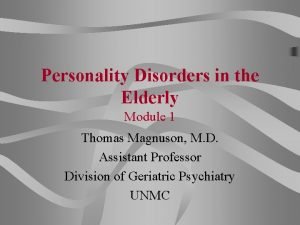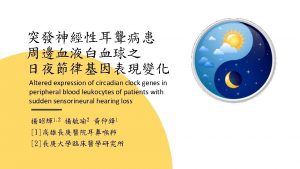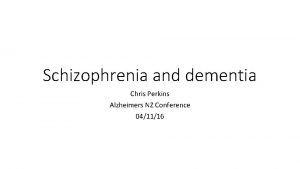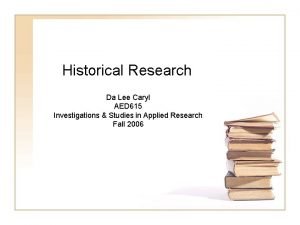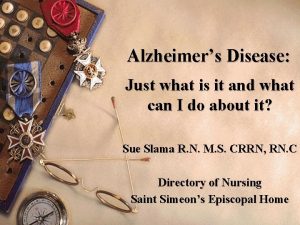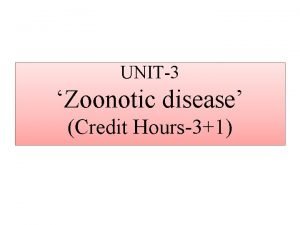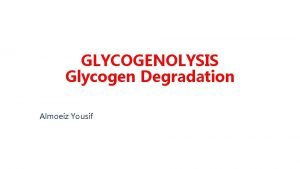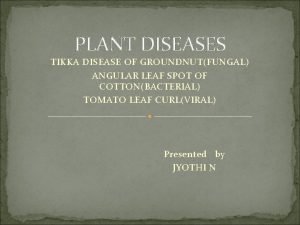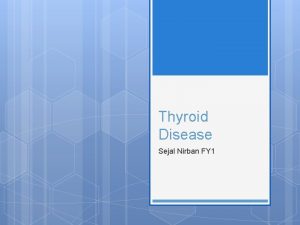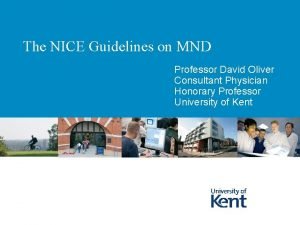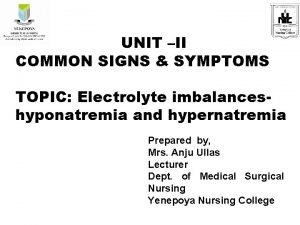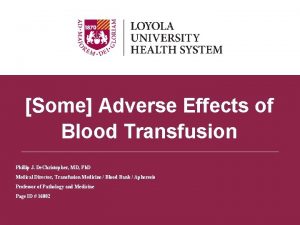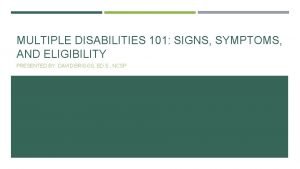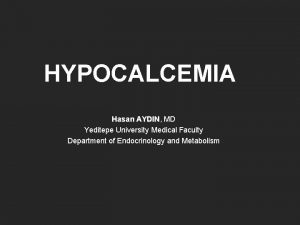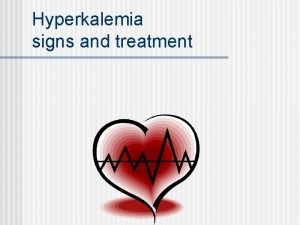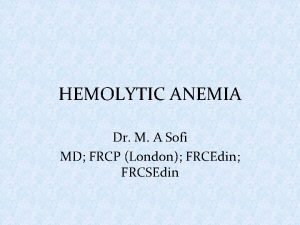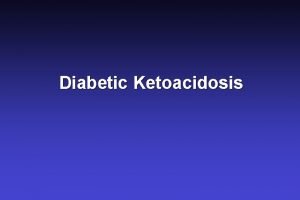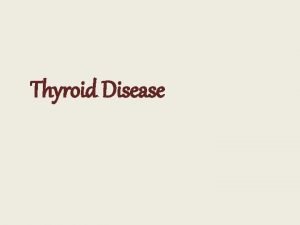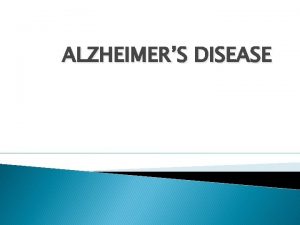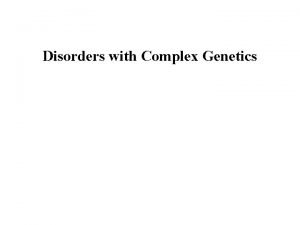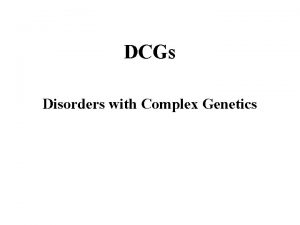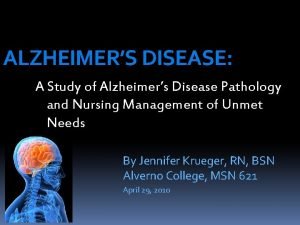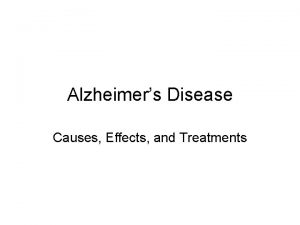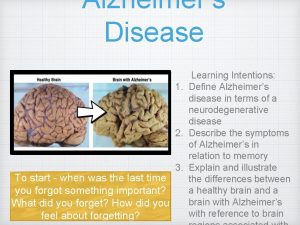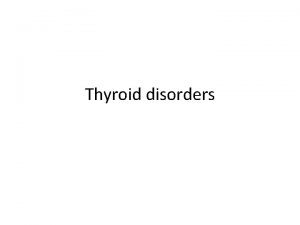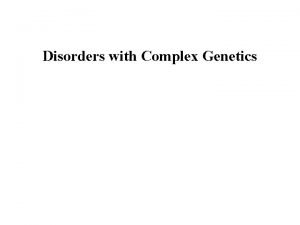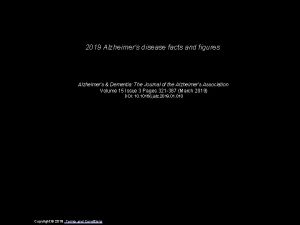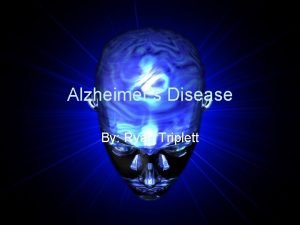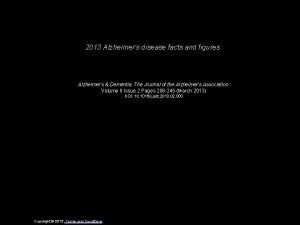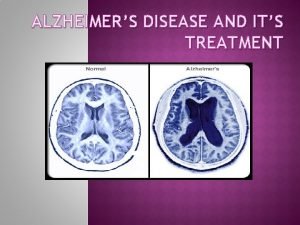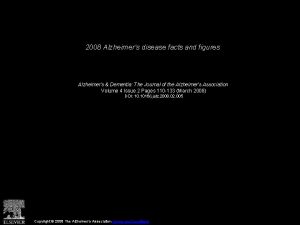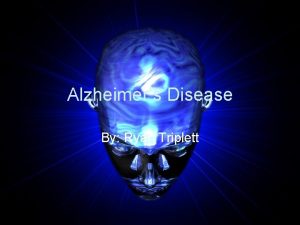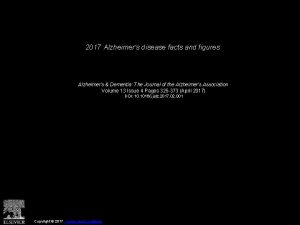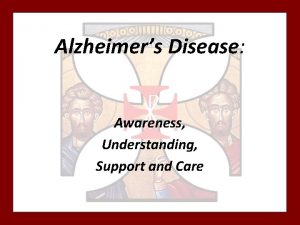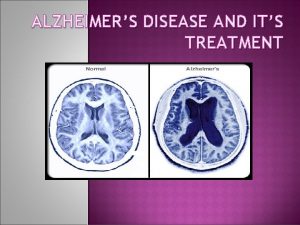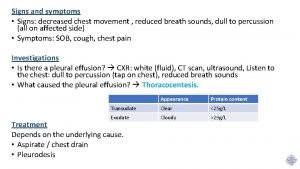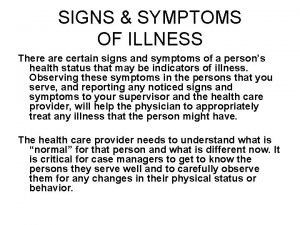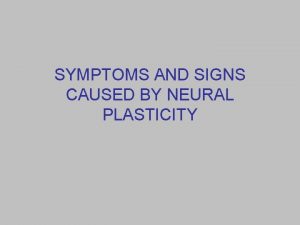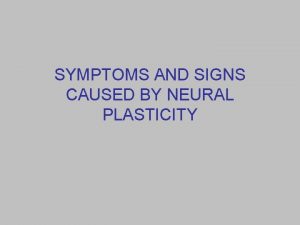Disorders with Complex Genetics Alzheimers Disease Signs Symptoms





































- Slides: 37

Disorders with Complex Genetics Alzheimer’s Disease

Signs & Symptoms: • Memory loss for recent events • Progresses into dementia almost total memory loss • Inability to converse, loss of language ability • Affective/personality disturbance (fatuous, hostile) • Death from opportunistic infections, etc. Confirmation of Diagnosis: • Neuronal (amyloid, b amyloid, Ab amyloid) plaques • Neurofibrillary tangles • Brain Atrophy

Neuronal Plaques in Alzheimer’s Disease From http: //www. rnw. nl/health/html/brain. html

Neurofibrillary Tangles in Alzheimer’s Disease From http: //www. rnw. nl/health/html/brain. html

Plaques and neurofibrillary tangles From Department of Pathology, Virginia Commonwealth University

http: //www. hosppract. com/genetics/9707 gen. htm

Brain Atrophy in AD WRONG! http: //abdellab. sunderland. ac. uk/lectures/Neurodegeneration/References/Brain_Neurons_AD_Normal. html

Classification: (1) FAD v SAD: Familial AD versus Sporadic AD • No complete consensus • Usually FAD = at least 1 first degree relative affected • Sometimes 2 second degree relatives (2) Early v Late Onset: • Early onset = usually before 65 • Early onset correlated with FAD • LOAD = late onset AD

Breakthrough: (1) Down’s Syndrome • Have AD brain pathology in later life • Usually, do NOT have AD symptoms (2) Pedigrees with dominant-like transmission: • Studied these first • Concentrated on chromosome 21

Alzheimer’s Disease, Type 1: • Several mutations in APP gene on chromosome 21 • Most common = Val 717 Iso • Produce abnormal beta amyloid fragment • 15%-20% of early onset, familial AD • Autosomal dominant http: //ghr. nlm. nih. gov/condition=alzheimerdisease

http: //perso. wanadoo. fr/alzheimer. lille/APPmutations. html

Alzheimer’s Disease, Type 3: • Mutations (> 130) in the presenilin 1 gene on chromosome 14 • Most mutations lead to amino acid substitution • Overproduction of the beta amyloid fragment • 30% - 70% of early onset, familial AD • Autosomal dominant

Alzheimer’s Disease, Type 4: • Mutations in the presenilin 2 gene on chromosome 1 • 2 alleles: Asn 141 Iso and Met 239 Val • Overproduction of the beta amyloid fragment • < 5% of early onset, familial AD (only a few families world wide) • Autosomal dominant

Alzheimer’s Disease, Type 2: • Epsilon 4 (e 4, AKA E 4) allele of the Apolipoprotein E (Apo. E) gene on chromosome 19 confers risk • Epsilon 2 (e 2, AKA E 2) allele of the Apolipoprotein E gene on chromosome 19 confers protection • Mechanism unclear; Apo. E is a very low density lipoprotein that transports cholesterol • Most cases are late onset, familial • Susceptibility Locus

Prevalence of APOE genotypes in Alzheimer’s disease (AD) and controls. Genotype: Controls AD E 2/E 2 1. 3% 0% E 2/E 3 12. 5% 3. 4% E 2/E 4 4. 9% 4. 3% E 3/E 3 59. 9% 38. 2% E 3/E 4 20. 7% 41. 2% E 4/E 4 0. 7% 12. 9% Jarvik G, Larson EB, Goddard K, Schellenberg GD, Wijsman EM (1996) Influence of apolipoprotein E genotype on the transmission of Alzheimer disease in a community-based sample. Am J Hum Genet 58: 191 -200

http: //www. hosppract. com/genetics/9707 gen. htm

Two Major Hypotheses for AD: b amyloid protein (BAP) v. tau 1. BAPtists: The accumulation of a fragment of the amyloid precursor protein or APP (the amyloid beta 42 residue fragment or Ab-42) leads to the formation of plaques that someone kill neurons. 2. TAUists: Abnormal phosphorylation of tau proteins makes them “sticky, ” leading to the break up of microtubules. The resulting loss of axonal transport causes cell death. (Recently a presenilin hypothesis has been proposed by Shen & Kelleher (2007), PNAS, 104: 403 -408. )

Amyloid Hypothesis (it’s the plaques, dummy) 1. The amyloid precursor protein (APP) is broken down by a series of secretases (see next two slides). 2. During this process, a nonsoluble fragment of the APP protein (called Ab -42) accumulates and is deposited outside the cell. 3. The nonsoluble or “sticky” nature of Ab-42 helps other protein fragments (including apo. E) to gather into plaques. 4. Somehow the plaques (or possible the migration of Ab-42 outside the cell) cause neuronal death. 5. PSEN 1 & PSEN 2 genes subunits of g secretase.

Amyloid precursor protein (APP) is membrane protein that sits in the membrane and extends outward. It is though to be important for neuronal growth, survival, and repair. From: www. niapublications. org/pubs/unraveling/01. htm

Enzymes cut the APP into fragments, the most important of which for AD is called b-amyloid (beta-amyloid) or Ab. From: www. niapublications. org/pubs/unraveling/01. htm

Beta-amyloid is “sticky” so the fragments cling together along with other material outside of the cell, forming the plaques seen in the AD brain. From: www. niapublications. org/pubs/unraveling/01. htm

b-secretase Pathway: (not drawn to scale) APP Protein: b a g g (1) b-secretase cuts APP protein, giving: (2) g-secretase cuts this residue, giving: Ab 40 Fragment Soluble Ab 42 Fragment Unsoluble, aggregates into plaques or

Tau Hypothesis (it’s the tangles, dummy) 1. Ordinarily, the t (tau) protein is a microtubule-associated protein that acts as a three-dimensional “railroad tie” for the microtubule. The microtubule is responsible for axonal transport. 2. Accumulation of phosphate on the tau proteins cause “paired helical filaments” or PHFs (like two ropes twisted around each other) that accumulate and lead to the neurofibrillary tangles (NFT). PHFs are the main component in NFTs. 3. Impaired axonal transport is the probable cause of cell death. 4. Focus on MAPT gene (microtubule-associated protein tau) 5. Not in favor anymore.

Current theory: Multifactorial, involving several pathways. • Protein accumulation: placques & tangles • Inflammation: Unregulated activation of glia • Lipid distribution: Lipid membrane site of APP cleavage.

From Sleegers et al. (2010) Trends in Genetics, 26, 84 -94, p. 87

Alzheimers Disease http: //www. ambion. com/tools/pathway. php? pathway=Alzheimer's%20 Disease%20 Pathway

Current gene candidates for AD: • Changes too rapidly to keep track of. • Go to http: //Alzgene. org for latest list

Microtubules are like railroad tracks that transport nutrition and other molecules. Tau-proteins act as “ties” that stabilize the structure of the microtubules. In AD, tau proteins become tangled, unstabilizing the structure of the microtubule. Loss of axonal transport results in cell death.

AD: The Great Unknown What is causing the majority of AD cases?

Cases with no known etiology: (theoretical extremes) Mendelian/ Phenocopy Disease (Genetic) Heterogeneity Multifactorial/ Threshold CDCV Common disease/ common variant

Heterogeneity Mendelian/Phenocopy • Many rare alleles with high penetrance (“Mendelian” forms of the disorder). • Almost no person will get two or more of these AD alleles. • Non familial cases due to phenocopies.

Multifactorial Threshold Model • Many common alleles with “low” penetrance. • Most people will have several risk alleles. • Risk alleles are additive (multiplicative). • Many additive environmental factors. • Genes and environment liability. • Once liability reaches a certain value (i. e. , the threshold) a disease process begins.

HGSS: Carey: Figure 6. 1

Theoretical major causes of AD:

Animal Models Human APP gene Mice gratia http: //www. kidscolorpages. com/mouse. htm Human Apo. E gene Human Presenilin gene

Figure 1. Development of the Transgenic Mouse Model of Alzheimer's Disease. The transgene consists of the human APP gene containing a mutation causing a rare form of early-onset familial Alzheimer's disease (Val 717 Phe). The transgene, whose expression is driven by the platelet-derived growth factor (PDGF) promoter, is microinjected into mouse eggs and implanted in a pseudopregnant female mouse. After the progeny are screened for the presence of the transgene, they are bred and their offspring are analyzed for pathologic features characteristic of Alzheimer's disease. The brains of the transgenic PDAPP (PDGF promoter expressing amyloid precursor protein) mice have abundant -amyloid deposits (made up of the A peptide), dystrophic neurites, activated glia, and overall decreases in synaptic density. From NEJM Volume 332: 1512 -1513

From Mc. Gowan, Erikson & Hutton (2006), Trend in Genetics, 22: 281 -289.
 Signs signs everywhere signs meaning
Signs signs everywhere signs meaning Cluster c personality disorders
Cluster c personality disorders Does pregnancy feel like period cramps
Does pregnancy feel like period cramps Parkinson's disease genetics
Parkinson's disease genetics Georgia alzheimers planning
Georgia alzheimers planning Fast scale
Fast scale Alzheimers sjukdom
Alzheimers sjukdom Alzheimers nz conference 2020
Alzheimers nz conference 2020 Historical research
Historical research Alzheimers society contented dementia
Alzheimers society contented dementia Alzheimers eye test joke
Alzheimers eye test joke Prion disease symptoms
Prion disease symptoms Modern treatment of heart disease
Modern treatment of heart disease Significance of glycogenolysis
Significance of glycogenolysis Tikka disease of groundnut symptoms
Tikka disease of groundnut symptoms Graves disease symptoms
Graves disease symptoms Motor neurone disease symptoms
Motor neurone disease symptoms Symptoms of parkinson's disease
Symptoms of parkinson's disease Symptoms of crohn's disease
Symptoms of crohn's disease Hyperkalemia signs and symptoms
Hyperkalemia signs and symptoms Icaada
Icaada Trali symptoms
Trali symptoms Symptoms of shock
Symptoms of shock Victoria climbe
Victoria climbe Neuroblastoma signs and symptoms
Neuroblastoma signs and symptoms Signs and symptoms of multiple disabilities
Signs and symptoms of multiple disabilities Hypocalcemia symptoms
Hypocalcemia symptoms Hypocalcemia signs and symptoms
Hypocalcemia signs and symptoms Signs and symptoms of hyperkalemia
Signs and symptoms of hyperkalemia Signs of low potassium
Signs of low potassium Hemolytic anemia signs and symptoms
Hemolytic anemia signs and symptoms Dka signs and symptoms
Dka signs and symptoms Types of sudden illness
Types of sudden illness Inokuchi shunt
Inokuchi shunt Hyperkalemia
Hyperkalemia Signs and symptoms of trali
Signs and symptoms of trali Myxedema coma signs and symptoms
Myxedema coma signs and symptoms Hypokalemia signs and symptoms
Hypokalemia signs and symptoms

